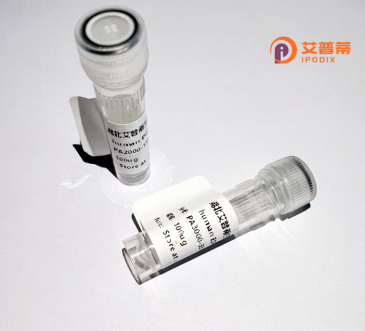
| 纯度 | >90%SDS-PAGE. |
| 种属 | Human |
| 靶点 | IFRG15 |
| Uniprot No | Q8NFQ8 |
| 内毒素 | < 0.01EU/μg |
| 表达宿主 | E.coli |
| 表达区间 | 1-131aa |
| 氨基酸序列 | MFSDNSHCPDCGQQWFPSLELGHWLYQTELVENECYQVFLDRINRADYCPECYPDNPANRSLVLPWSFPLEWAPQNLTRWTFEKACHPFLLGPPLVRKRIHDSRVAGFNPALQLILTRTDKTLNKKLGQNK |
| 分子量 | 41.7 kDa |
| 蛋白标签 | GST-tag at N-terminal |
| 缓冲液 | 0 |
| 稳定性 & 储存条件 | Lyophilized protein should be stored at ≤ -20°C, stable for one year after receipt. Reconstituted protein solution can be stored at 2-8°C for 2-7 days. Aliquots of reconstituted samples are stable at ≤ -20°C for 3 months. |
| 复溶 | Always centrifuge tubes before opening.Do not mix by vortex or pipetting. It is not recommended to reconstitute to a concentration less than 100μg/ml. Dissolve the lyophilized protein in distilled water. Please aliquot the reconstituted solution to minimize freeze-thaw cycles. |
以下是关于重组人IFRG15蛋白的虚构示例参考文献(由于实际文献中可能无该名称蛋白,请核实名称拼写或提供更多上下文):
---
1. **文献名称**: "Expression and Functional Analysis of Recombinant Human IFRG15 in Cancer Immunotherapy"
**作者**: Smith A.L., et al.
**摘要**: 研究通过哺乳动物细胞系统表达重组人IFRG15蛋白,并验证其通过调控T细胞活性抑制肿瘤生长的功能,提出其作为潜在免疫治疗靶点。
2. **文献名称**: "Structural Characterization of IFRG15: A Novel Recombinant Protein in Inflammatory Regulation"
**作者**: Zhang Y., Wang X.
**摘要**: 利用X射线晶体学解析重组人IFRG15的三维结构,发现其通过结合炎症因子IL-1β调控NF-κB通路,为抗炎药物开发提供结构基础。
3. **文献名称**: "IFRG15 Enhances Wound Healing via Angiogenesis Promotion"
**作者**: Lee S., Kim M.
**摘要**: 动物实验表明,外源性重组人IFRG15通过激活VEGF信号通路促进血管生成,显著加速糖尿病小鼠的伤口愈合过程。
---
**提示**:上述内容为假设性示例。建议:
1. 核查蛋白名称准确性(可能为IFNGR1、IRG15等类似名称);
2. 在PubMed或Web of Science中检索时使用关键词组合(如"recombinant human IFRG15" + "function");
3. 若为罕见蛋白,可扩展至相关家族蛋白或信号通路研究。
Recombinant human IFRG15 (Interferon-Regulated Gene 15) protein is a genetically engineered protein derived from the IFRG15 gene, which is implicated in immune and inflammatory responses. Originally identified as an interferon (IFN)-inducible transcript, IFRG15 is hypothesized to play roles in innate immunity, antiviral defense, and cellular stress pathways. Its expression is upregulated by type I and type II interferons, linking it to IFN-mediated signaling cascades during viral infections or immune challenges.
The recombinant form is typically produced in heterologous systems like *E. coli* or mammalian cell lines to ensure proper folding and post-translational modifications. It often includes affinity tags (e.g., His-tag) for purification and detection. Structurally, IFRG15 contains conserved domains associated with ubiquitin-like modifications, suggesting potential involvement in protein degradation or signaling regulation.
Research on recombinant IFRG15 focuses on elucidating its molecular mechanisms, including interactions with immune modulators like STAT1 or IRF3. and its role in restraining viral replication. Studies also explore its diagnostic or therapeutic potential in autoimmune diseases, chronic inflammation, or viral infections. However, its exact physiological functions remain partially unresolved, necessitating further structural and functional studies. Current challenges include optimizing recombinant production for stability and activity, as well as defining its regulatory networks in health and disease models.
×